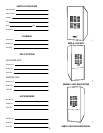
4
The operation and care of your unit is simple and easy.
By following these operating and maintenance proce-
dures, you can expect to receive better, longer, and
more reliable service from your new appliance.
COMBUSTION AIR REQUIREMENTS
Combustion air requirements become more important
for your new furnace. More efficient units have lower
flue temperatures and less natural draft. Especially
with new homes and with older homes that have been
weatherized (storm windows, vinyl siding, additional
insulation, etc.) infiltration air may no longer be
enough to supply the necessary combustion air to your
furnace. In these cases outside air will need to be in-
troduced into the furnace location or directly into the
furnace vestibule. This can be accomplished by means
of louvered openings, ductwork, or tubing. Your dealer
or service technician has access to the necessary air
requirements specified by the National Fire Protection
Agency.
Some symptoms of a lack of the proper amount of
combustion air are:
1. Excessive oil burner after drip and oil fumes.
2. Sooting.
3. Melted oil burner couplings and/or ignitor/relay
control.
4. A condition where air band or air shutter settings
must be more open than normal to achieve proper
combustion.
5. Lockouts on start-up.
HERE ARE A FEW DO’S AND
DO NOT’S
•
DO
become familiar with the instructions.
•
DO
use filters. Check them periodically and make sure
that they are clean.
•
DO
check to see that your home has adequate insula-
tion, weatherstripping, caulking, and storm windows.
Eliminating infiltration of outside air and drafts can save
up to 40% of your fuel bill.
•
DO NOT
waste fuel by setting your thermostat too
high. Energy conservation experts recommend daytime
thermostat setting of 68
°
F, with a lower setting at night.
•
DO NOT
turn off the furnace when you expect to be
away for more than a day. Instead, lower the thermostat
setting by a few degrees. You can then restore normal
comfort level quickly and save fuel too.
•
DO NOT
block registers with furniture.
•
DO NOT
put a lamp, TV, or radio near your thermo-
stat. This will cause it to give a false reading.
HERE’S HOW YOUR
HEATING SYSTEM WORKS
The furnace operates automatically. It is controlled by a
thermostat which you set at the temperature most com-
fortable to you. When the inside temperature drops be-
low this setting, your thermostat starts the furnace.
When the thermostat calls for heat, power from the
transformer energizes the fan control board. The fan
control energizes the ignition control. The ignition con-
trol automatically lights the burner.
The electronic fan control automatically turns on the
blower after 30 sec. Fan on control is not adjustable. The
air moved over the heat exchanger by the blower is
warmed and passes through the ducts to the room regis-
ters.
When the thermostat is satisfied, the circuit is de-ener-
gized and the primary control shuts off the burner. The
blower continues to run until the selectable fan off time
period has expired.
WARNING
The unit cabinet must have an uninterrupted
or unbroken electrical ground to minimize
personal injury if an electrical fault should
occur. This may consist of electrical wire or
approved conduit when installed in accor-
dance with existing electrical codes. Do not
use oil piping as an electrical ground. Fail-
ure to follow this warning could result in an
electrical shock, fire, or bodily harm.
WARNING
Return air must not be taken from the room
in which the appliance is installed. All duct
connections to the furnace must be airtight
to avoid a “negative” pressure condition
within the room. Incorrect ductwork termi-
nation and sealing will create a hazardous
condition which could lead to bodily harm.
CAUTION
The ability to properly perform maintenance
on this equipment requires certain mechan-
ical skills and tools. If you are at all uncer-
tain, contact your dealer for qualified
maintenance and service.
!
!
!










